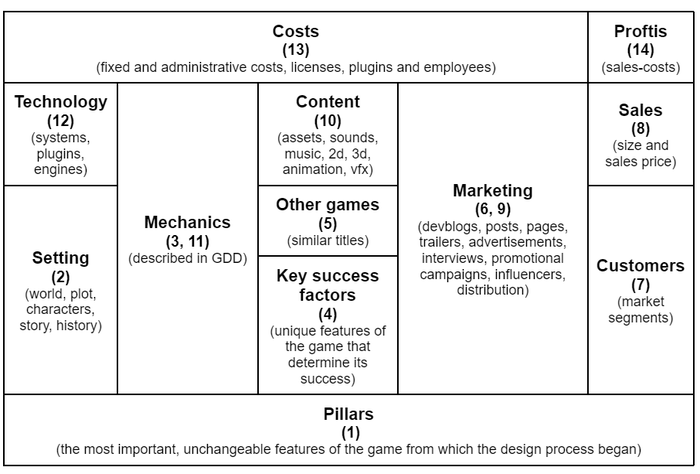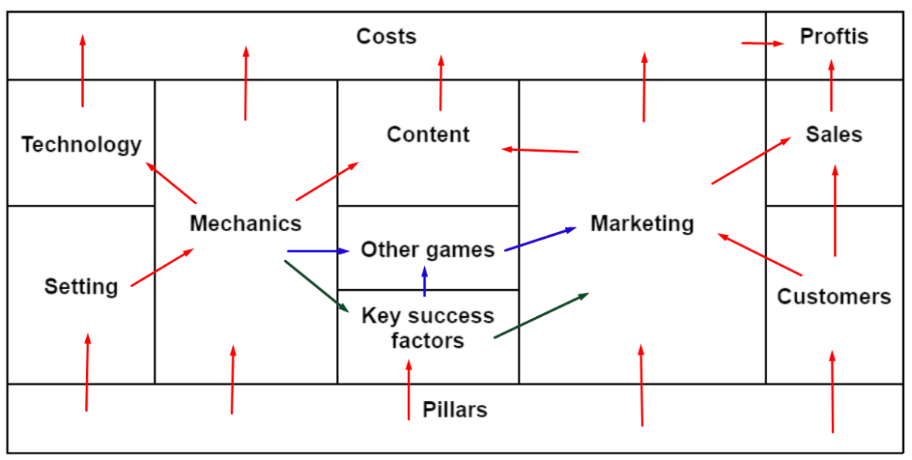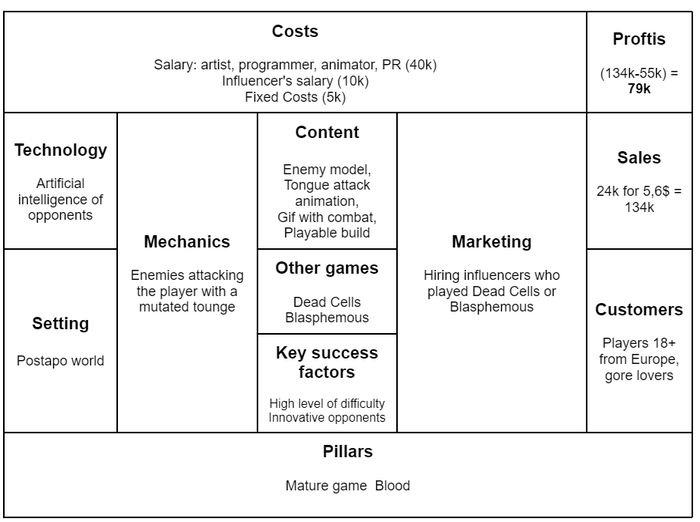Game Development Canvas - a new method of presenting and managing a game project
Just as Lean Canvas is a one-page business plan, eagerly used by startups, Game Development Canvas is intended to be a one-page analysis of the game, a primary and transparent document through which we can track progress and supervise the entire process.

Game Development Canvas is a method derived from Lean Canvas, which I developed for the purpose of carrying out expert opinions for investment funds interested in the gaming industry. We tested it directly for game production at Strategy Forge, and after its merger with Jujubee, we implemented it in the second studio. Its goal is to create a one-page document with which we can determine the consistency and needs of mechanics and marketing, determine the audience, costs and profits from game production. Just as Lean Canvas is a one-page business plan, eagerly used by startups, Game Development Canvas is intended to be a one-page analysis of the game, a primary and transparent document through which we can track progress and supervise the entire process.
Game Development Canvas

We fill the tables iteratively, always starting from the bottom, moving from left to right, and then coming back. Because all fields are related to each other, if we make any changes during iteration, we must repeat the process - until we have checked all fields and have not edited anything. If you want to make the most of the method, it is worth checking the fields periodically - preferably at the end of each milestone. This will allow us to check whether we are not deviating from the initial assumptions, but also whether we are carrying out all tasks in accordance with the plan and whether the cost forecasts and the expected reception of the game have not changed.
First iteration
So, when filling out the table, we start by defining the pillars of the game. We define them in accordance with the generally accepted methodology - we provide the game genre, atmosphere, style, and the most important assumptions that constitute the basis of the game in GDD. Virtually unchangeable and inviolable features of our production.
Then we describe the Setting of our game - i.e. the game world, its history, the plot, characters, story - we should list the most important elements here. We connect the Setting elements with the Pillars, and if they do not fit, this is the first sign of inaccuracy in our idea - we mark such an element as requiring further work. Each element that we cannot combine with others should be marked appropriately.
In the next stage, we move on to Mechanics - here we write down the mechanics that we plan to include in the game (actually, we should enter here all the headings from the exact, full GDD or milestone plan). Once we fill in this field, we determine which mechanics are derived from the Setting and how they connect to the Pillars. Again, we mark mechanics that are missing connections.
The fourth stage is to determine Key Success Factors (KSFs). We fill in this field with the KSFs we have defined and then try to connect them with the appropriate Mechanics and Pillars.
Then we move up the field to Other games. We enter productions that are similar to ours and try to define which of our KSFs were also KSFs for those games. We determine which of our mechanics are also available in similar games.
We can take care of Marketing. We enter the assumptions of marketing campaigns into the field - promotional campaigns we want to carry out, advertisements, cooperation with influencers, marketing messages, distribution, etc. Then we determine which KSFs we want to emphasize with a specific action and connect them with the Pillars. We choose which titles from the Other games field could be promoted using our activities.
In the Customers field, we enter our segments, in accordance with the chosen market division method. We assign an element of a Marketing campaign to each segment. We determine which Pillars are important for specific target groups. Thanks to this, we can define which groups are more or less targeted.
After this stage, we can focus on the Sales field, which should reflect the purchasing behavior of individual segments - the proposed price and sales volume in a given market area. Now we go back to the left and determine which Sales volumes relate to which Marketing elements. We can also consider what marketing campaigns can help increase sales in a given group.
We go to Content and determine what we will need to complete the game - what texts, graphics, models, animations, scenes, sounds, musics, sfx, vfx, etc. Then we determine which of them we will be able to use in specific Marketing campaigns and indicate how they are connected with Mechanics.
From Mechanics, we move to the Technology field and specify what we will need to implement a specific Mechanic - whether we need to write a new shader, a new database, some larger system in the game, what plugin we will need or whether the mechanics are something standard that gives us the engine itself. Mechanics are, for example, an AI opponent hiding behind a cover, and Technology is Artificial Intelligence or a cover system.
We can deal with the penultimate field, i.e. costs. Here we define how much we will have to pay for developing specific Technologies, creating Mechanics, producing Content and Marketing campaigns. It is worth remembering about licenses, plugins and fixed costs (office, administration, etc.).
The last field is the result of Costs and Sales - thanks to this we can find out how much we should earn (or lose) on our game. The first iteration is behind us. Now it's time for the second iteration and looking for problematic elements.
Second iteration
This action involves searching for connections between appropriate fields. We can, of course, add new ideas, but these will require re-analysis of the entire table.
The connection diagram is as follows:

Red connections must always be present. Blue and green can appear together or separately, but there must always be at least one group. The arrows indicate the best relationships (i.e. a given field should result from the field next to it) but it does not always have to be this way - it is possible to create mechanics that will result from the needs of a given group of recipients, and then the order will be reversed. The most important thing is to maintain the connection between the elements.
We start with the Pillars again - we consider whether each Pillar has connections to an element from each of the higher cells. If the Pillar has not connections to:
Setting or Mechanics - not reflected in the game. It is purely a marketing item that you promise but do not deliver.
KFSs - the pillar is not important for the project - maybe it is worth removing it or replacing it with another one?
Marketing - you do not properly emphasize the pillar in the promotional campaign
Customers - no one cares about this pillar, perhaps it is worth replacing it with something more tailored to your audience
We check the Setting connections. If there is no connection to:
Pillar - the element is not important from the point of view of the game, or does not fit into the overall game
Mechanics - the element is not emphasized in the game. It is worth considering whether to give it up or emphasize it more strongly.
Mechanics and Pillar - usually an element to be removed
If Mechanics is not connected to:
Technology - we don't know how to do it, we haven't included it in the costs
Asset - we don't know what else will be needed, we haven't included it in the costs
Pillar - the mechanics do not fit the game or are irrelevant to it
KSFs, but it has connections with Other games - the mechanics are a copy from another game, it is worth considering whether it is necessary to add it (very often it is an important mechanic, but we must remember to also have our own elements!)
KSFs and there is no connection with Other games - the mechanic does not matter, or we did not include some KSFs or another game
Setting - does not depend on the game's atmosphere, it may be worth introducing some modifications to emphasize the game world more strongly
Other games, but with KSFs - this is the main innovation of the production
Costs - we did not take into account its price
If KSFs is not connected to:
Pillars - pillars are missing
Mechanics - we do not meet the KSFs, our production does not offer what we think - we need to modify the mechanics or remove the KSFs
Marketing - we do not promote our KSFs
Other game - it's an innovative KSFs, which should be strongly emphasized, thanks to it we stand out
If Other games have no connection with:
Mechanics or KSFs - we do not fit into this production
Marketing - we do not direct the game to the recipients of this production
If Marketing is not connected to:
Content - we do not have materials for a given campaign
KSFs - the campaign does not emphasize the game's strengths
Other games - the campaign is not addressed to players of a given titles
KSFs and Other games - the campaign is not connected to our game, it does not talk about its mechanics, features or similarities
Customers - the action is not addressed to the right people
Sales - the action will not bring financial benefits
Costs - we did not take into account the price of the campaign
If Customers are not connected to:
Marketing - we do not carry out any marketing activities directed at them. They won't know about the game.
Sales - we do not monetize recipients - we do not assume revenues from this segment
If the Sales is not combined with:
Customers - we do not know where a given sales volume will come from
Marketing - we don't know how we will ensure a given sales volume
If Content are not connected to:
Marketing - we do not use them in promotional campaigns
Mechanics - we do not use them in the game
Marketing and Mechanics - we probably don't need this asset
Costs - we did not take into account their price
If the Technology is not connected to:
Mechanics - we don't use it in the game
Costs - we did not take into account its price
If the cost is not connected to:
Mechanics, Technology, Content, Marketing - it is a fixed cost, or we do not know where it comes from
Profit - we did not take it into account in the assessment of the game's profitability
If Profit has no connection with:
Cost - we did not take into account a given cost
Sales - we did not take into account the given revenue.
Other iterations
After completing this iteration, we should perform another one, starting from the Pillars again. Introducing any change, like adding or subtracting a connection, adding or removing an element, we must perform a new, subsequent iteration until we achieve passage through the entire table without making any edits. At this point, we have the entire project in front of us - we are able to determine its profitability, the reasonableness of individual mechanics and their consistency - both with the budget, game concept and marketing.

The ideal mechanic is one that has full connections, i.e. it corresponds to an element from the Setting, we know the Technology we need for it, we know the Content, it is an element of KSFs or Other game or both (preferably KSFs itself), it is an element of a Marketing campaign , has its Customers and influences Sales. Of course, assuming that Sales affect Profits; and Technology, Mechanics, Marketing, Content have their Costs; and Setting, Mechanics, KSFs, Marketing and Customers are connected by the same Pillars.
It is worth analyzing individual elements, their connections with others, including the number of connections and costs - thanks to this we are able to find mechanics that are very expensive, but do not appear in Other games and are not our KSFs, which we market poorly and have little impact on Sales. We can find mechanics that are relevant to all Customers, but are not reflected in the game world or Pillars. Any incomplete connection means some trouble or inconsistency. The longer and more branched the connections, the more coherent and well-thought-out the entire game production process is.
If you are interested in game production, I will be very pleased if you visit me on my blog.
Read more about:
BlogsAbout the Author
You May Also Like









